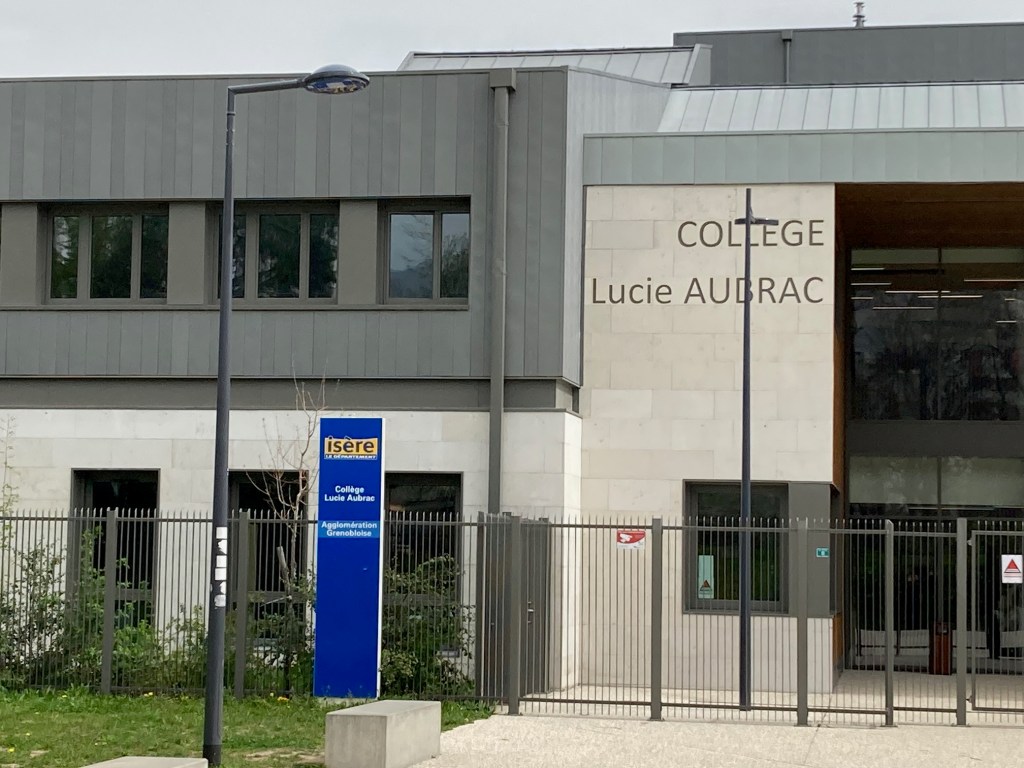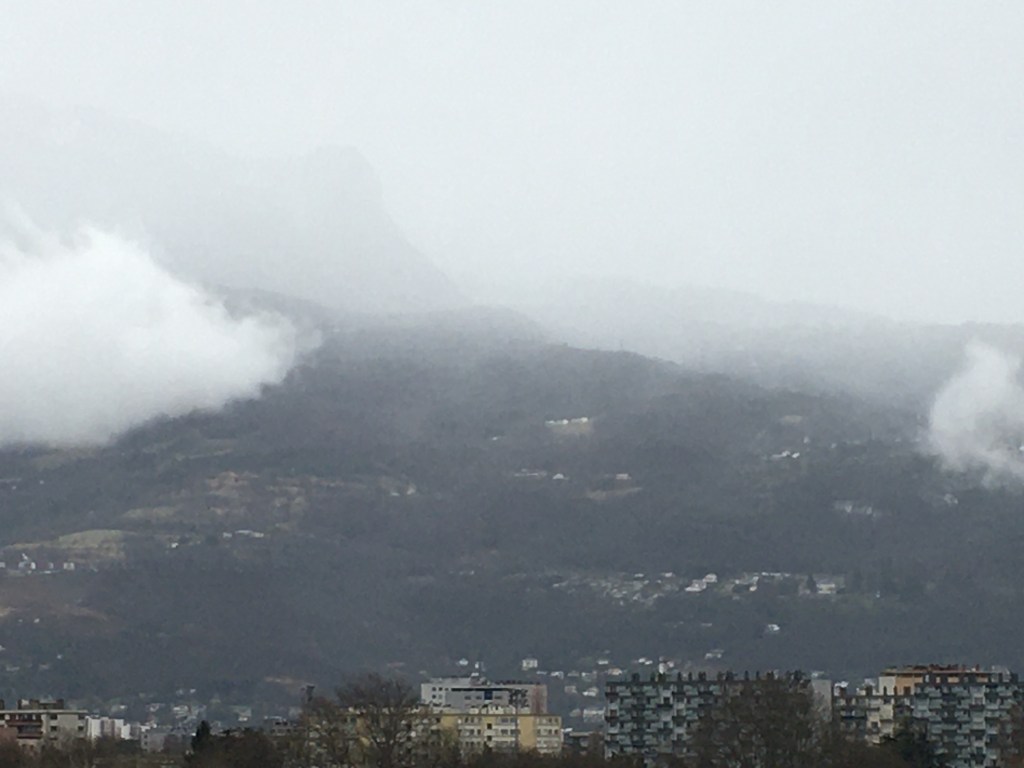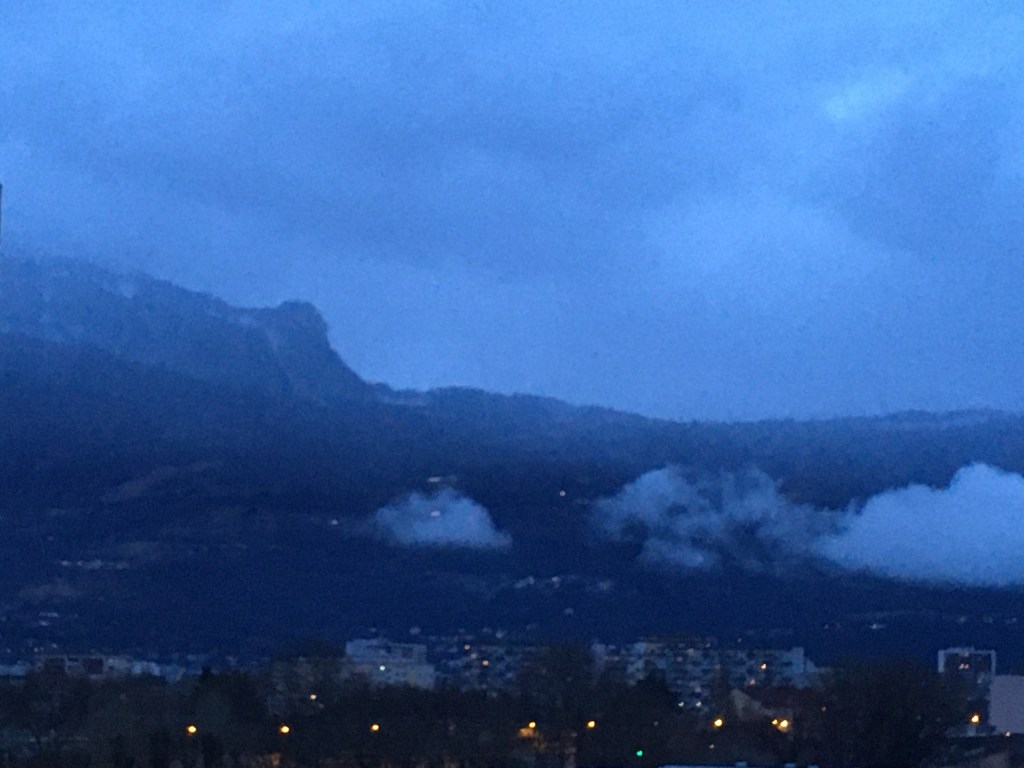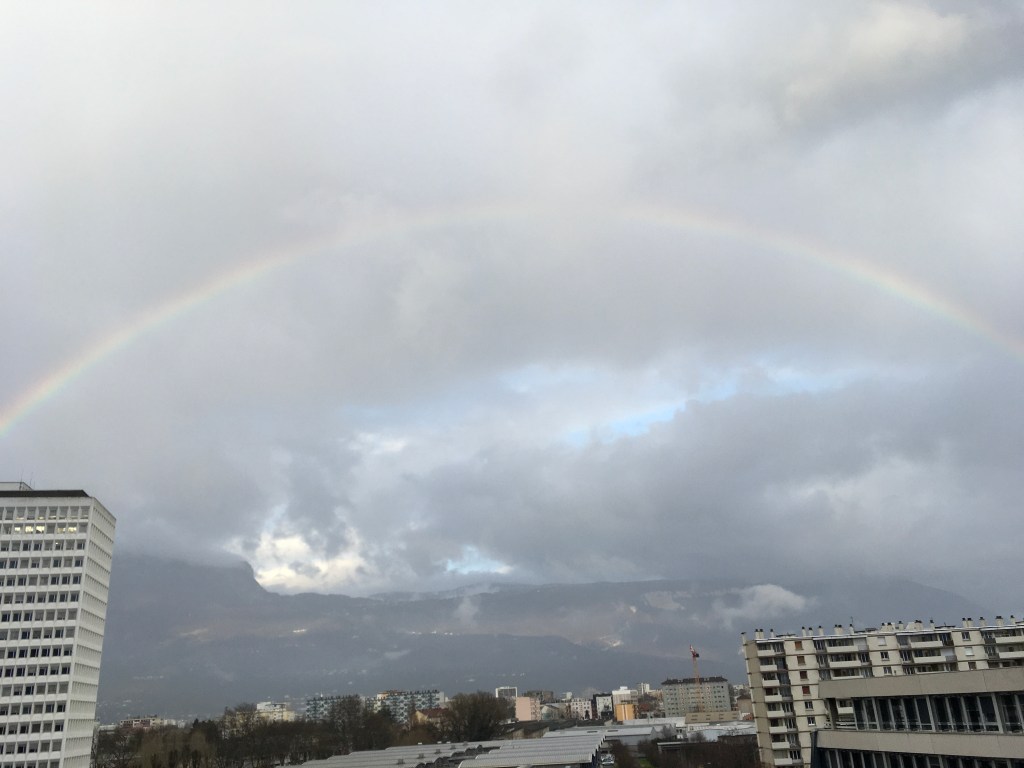Leaving Grenoble
For Good Friday evening we had a Tenebrae service in the smaller chapel in the Centre St Marc. About twenty people came, for a service largely put together by David Bailey. It was a sober, thoughtful time in the semi-darkness, a selection of short readings and music culminating with Allegri’s Miserere. On Saturday morning, our penultimate day, Susie and I went out to breakfast again at Pain et Cie, which is all wooden tables and non-matching chairs in the pedestrian quarter.


The clocks changed on Saturday night, so we were very thin on the ground at 10.45am on Sunday morning. But people trickled in, and we ended with a decent crowd as we thought about The Empty Tomb and celebrated the good news of Jesus’s resurrection. After lunch I walked round Villeneuve for a last time. Past the Collège Lucie Aubrac. She was a great heroine of the French Resistance, a militant Communist, who took part in a number of dramatic resistance exploits, and was much praised by President Sarkozy when she died in 2007. She was married to Raymond Samuel [who took the name Aubrac during the war to conceal his Jewish origins], and she famously rescued him from Gestapo custody in a commando operation in 1943.

In his riveting book War in the Shadows: Resistance, Deception, and Betrayal in Occupied France [pub. 2020]which I was reading in Grenoble, Patrick Marnham suggests that the Aubracs may have collaborated with the Germans, to the extent that Raymond Aubrac may have betrayed Jean Moulin at the much written about meeting at the house of Dr. Dugoujon in Caluire in June 1943. [Moulin was arrested, severely tortured by Klaus Barbie, and died very shortly afterwards.] Feelings run high about resistance history, but the facts are difficult, and probably now impossible, to establish.
Naomi kindly gave us a lift to the bus station. Dark clouds loomed over the north-west corner of the Vercors as we enjoyed the sièges panoramiques on the Flixbus. The flight was uneventful. Our taxi driver in Edinburgh was from Jordan, and we took it in turns to share strong views about Israel’s unacceptable behaviour in the Gaza strip and America’s continuing willingness to supply them with military weapons and hardware. Back in the house a fuse had tripped in the garage putting the boiler out of action. It was a cold house and a cold, rather short night.

Back in Edinburgh
We’ve been away a lot in the past six months. It has been raining since we arrived back, and the daytime temperature here peaked today at 8ºC. I sometimes wonder why we live in Edinburgh. According to my MacBook it will go on raining for the next two weeks. Which puts an end to my plans to cut the grass. In a fit of catching up, I had an appointment with Mary, the diabetic nurse, this morning; I have an appointment for a check-up with the dentist in Musselburgh next Monday; and I am going for an annual eye test next Wednesday. Every year I wonder whether it is time to get some prescription glasses. But for the moment I am still living with off the peg reading glasses from HEMA, in a variety of colours.
Amelia and Ellie are coming across from Fife for lunch tomorrow. It will be very good to see them. And it will be very good to see Jem and Anna, and Freya and Oskar, who are driving up from Watlington and who should arrive late tomorrow evening. Sadly it doesn’t look like weather for going out to Gullane or North Berwick. Or even walking on Arthur’s Seat. More like a visit to the Museum. Which could be crowded during the school holidays.
The following week I am going down to Sussex, for a 60th anniversary Leavers’ Reunion at Christ’s Hospital. It seems a long way to go for quite a short time. But CH had a big influence on my life. Of which more another time. And I have been in touch with one or two friends whom I look forward to seeing there. [There’s nothing much worse than going to a reunion and not knowing anyone.]
From Cross to Resurrection
With the help of an orange marker pencil, I have got to the end of Alan E Lewis’s magnum opus, Between Cross and Resurrection a theology of Holy Saturday. It is a big book. Which gives the impression of being written and rewritten over a long period of time, before the author died at the age of 50. [The book was published posthumously in 2001.] Perhaps in consequence I wasn’t sure that the different parts of the book hung together as well as I would have liked.

Part III of the book deals with Living the Story; in world history, and in contemporary society, and in personal life. Lewis asks: How does the gospel nurture hope in times of crisis ? His answer: “The only victory in life is won by going beyond … the expansive magnitude of death.” The early Church faced persecution and martyrdom. But the delay in the Parousia, the end of persecution, and the adoption of the Christian faith by the Roman emperor, Constantine, made the church more comfortable in the world and more optimistic about the future. After the Enlightenment, a secular version of Augustine’s optimism took hold: a belief in progress, and the certain triumph of human power, knowledge, and creativity.
This view of history died with the Great War; in the gas-filled, blood-soaked trenches of the Somme and Passchendaele. The twentieth century descended into chaos and catastrophe. Easter Saturday teaches us that the God of Jesus Christ does not [always] intervene to prevent catastrophe and rupture. While the Holocaust and Hiroshima show what wickedness humanity is capable of, Chernobyl exposes the fatal depths of our carelessness and inattention. Does God approve of what we have done; it is our destiny. Does God disapprove; yet is powerless.

For many people, only despair and pessimism remain to fill the gap left by the collapse of confidence. Against that view, Lewis insists: “this word of the raising of the crucified and buried God, … … might now address the multiple terminal crises of word history.” Theologians like Barth, Moltmann, and Jüngel all speak of divine self-fulfilment through suffering and self-negation. And the doctrine of the Trinity is the key.”The Spirit who unites the Father and the Son through their separation also holds together humanity and God, the Creator and the creatures.”
There are a lot of long words, many of them abstract. But some sections leap off the page in a timely way:
The death that unites humanity and deity must also reconcile Jew and Gentile in one body before God. Centuries of Christian pride, animosity, and anti-Semitism must be ended. Ethnic, racial, and religious animosity is most intransigent and most menacing in the Middle East. And in the relations between Israel and its Arab neighbours.
“If true solidarity can be founded on the similarity of Jews and Christians that can only be a critical solidarity, a willingness, on the basis of firmly established mutual respect, to cajole, criticise and prod each other … … This might mean that churches, and nations still subject to Christian public opinion, adopt a critical stance towards the government of Israel with respect to the treatment and the future of the Palestinians, insisting that the latter need no less an end to their own displacement and disenfranchisement than did European Jewry for far too many centuries.”

The final section of the book is moving and personal.
The author discloses his own situation: he has been undergoing high-dose chemotherapy following a cancer diagnosis. How could he write this book [he asks retrospectively] without having known an Easter Saturday experience himself ? The truth about human beings is that we shall all die. But central to the Easter story is that death does not have the last word. Lying in a hospital bed teaches us the ‘stature of waiting’.
God’s victory over death is not a matter of mere survival; but a new life and a new reality. The gospel promises that the lives we lived before death shall not be lost to God … “but that our identities and lives shall be gathered into God’s own life”.
Easter Saturday determines how we handle our own mortality. “To be mature is not just to live authentically with decay, disease, and bodily death, but to be a person who at any age or stage has died already and so been raised to life anew”. Lewis deplores the fact that being ‘born again’ has been appropriated by one narrow church faction. When Christian regeneration, he insists, should be basic church teaching, common to all traditions and denominations.
Baptism is “the seal of our repentance and rebirth, our death with Christ and union with his resurrection, which is our new identity”. To be baptised is to have an Easter Saturday identity.
“Easter Saturday, God’s day of burial, becomes for all who are baptised the event and sign of their old lives’ termination and the beginning of the new”.

It wasn’t an easy read. But I am glad to have persevered, while ignoring the footnotes which are many and various. And the book has certainly give me a bigger and deeper understanding of the whole Easter event.
April 2024